The Gregory Baltoro has long been the Rolls Royce of expedition-sized backpacks, combining superb load-carrying comfort with a highly functional set of pockets, access points, and external attachment options for wilderness backpacking and international trekking (available in 65L and 75L models). While the appearance and storage options on the current Baltoro 65 are quite similar to the previous model, the current model has a new frame and adjustable fit system that accommodates different torso lengths, hip belt lengths, and body shapes to dial in a custom fit. Available in multiple overlapping sizes (S,M,L), the backpack is also slightly lighter, bringing it under 5 lbs. We still think the Baltoro 65 is a winner and that the new fit system makes it much easier to size properly while eliminating the need to special order replacement components.
Specs at a Glance
- Type: Internal frame
- Weight: 4 lbs 14.4 oz in size, medium (includes 0.7 oz of optional components)
- Frame: Adjustable torso length and adjustable hip belt length
- Volume: 65L + extension collar and open pockets (approx 10L more)
- Gender: Men’s (the women’s model is called the Gregory Deva 60)
- Pockets: 8 closed, 3 open
- Access: Top, front panel, sleeping bag compartment
- Hydration compatible: Yes
- Load lifters: Yes
- Rain Cover: No
- Bear canister compatibility: BV500 fits vertically and horizontally (wow!)
- Materials: 210d (body) and 425d (base) high tenacity nylon, (135d lining) polyester
- Maximum recommended load: 50 lbs
Backpack Storage and Organization
The 65L Baltoro can hold an enormous amount of gear, far more than you’d expect in a 65L backpack. Gregory doesn’t include the extension collar volume or open pockets in their pack volume computations, which explains why the Baltoro can swallow so much gear (about 10-12 liters more than spec). In addition to the main compartment, the Baltoro also has 8 external closed pockets for storing gear: the main compartment, 3 pockets in the top lid, 2 on the hip belt, and 2 on either side of the front stretch pocket, along with 3 external open pockets: a front stretch mesh pocket, a tall side mesh pocket, and a collapsible water bottle sleeve sized to hold a 1L Nalgene bottle. The main compartment includes a hydration sleeve with two side hydration ports. Gone is the removable hydration pocket present on the previous generation Baltoro, which could be used as a day pack.
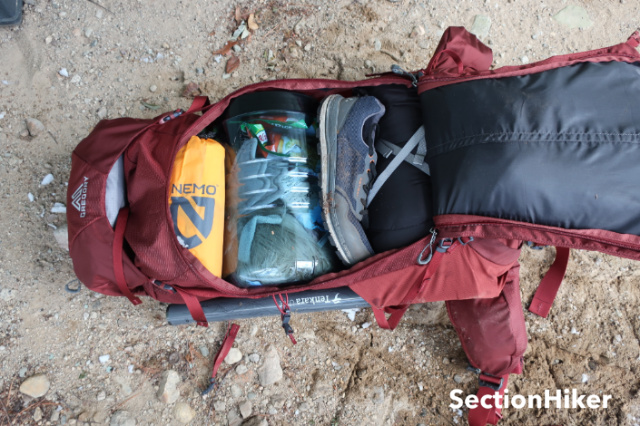
Main compartment
While the Baltoro is configured as a top-loading backpack with a floating lid pocket, there are several different ways you can access gear stored in the pack without having to pop the lid and grope around blindly inside to find it. These extra openings can be a real convenience on high-volume packs, so you can access gear without having to unpack it all.
The front of the pack can be opened with a large U-shaped zipper, panel-style, so you can pull out gear buried deep inside. There’s also a sleeping bag hatch that opens the bottom of the pack. There’s an optional fabric “shelf” that you can attach to toggles inside the pack to create a separate sleeping bag compartment, but you get better space utilization if you remove it. A bear canister, in this case, a BV500, can fit in the main compartment both vertically or horizontally, with room to spare, or lashed under the floating top lid pocket.

If you plan to take advantage of the front panel and sleeping bag pocket zippers, you’ll probably want to use waterproof stuff sacks to pack the gear stored in the main compartment since these access points are not compatible with a pack liner.
Floating Top Lid
The top lid is floating, so you can scrunch bulky gear underneath it, like rope, snowshoes, a tent body, or a sleeping pad if you need extra carrying capacity. The lid has three pockets, one small pocket on top, one large one, and a pocket on the underside of the lid. I like to put essentials in the small top pocket, like a headlamp, compass, map, and SmartPhone, while using the large pocket for gloves, hats, and snacks. The underside pocket is good for stashing my wallet, keys (on the provided key fob), and toiletry articles so they’re easily accessible but out of the way. This pocket can also be used to store the rain cover and still has lots of room left over.

Front Panel Pockets
The front panel flap has three pockets built into it, an open mesh stuffit pocket, and two long side pockets underneath it. The mesh pocket is good for storing wet gear like a water filter, rain layers, or snacks for fast access. The mesh is very durable, with small holes that resist snagging or tearing. The side pockets under the mesh pocket are long and tall, with enough capacity to hold a jacket, extra pair of shoes, or sandals, one on each side. You can also easily fit a small tent body or a hammock and tarp in these pockets, so you can set them up in the rain without having to open your pack up and expose the contents. All of the coil zippers on these pockets have burly #5 or #8 YKK sliders and are covered with rain flaps to reduce leaking.
Gregory Baltoro 65 Backpack
Comfort
Weight
Suspension
Features
Adjustability
Sizing
Durability
Expedition-Class Backpack
Side pockets
The Baltoro is a bit unusual because it doesn’t have symmetric side pockets. While there is a side mesh pocket on the left side of the pack, it’s not large enough to store a water bottle and is best used to capture the bottom of long skinny objects, like tent poles, glacier wants, or a collapsible fishing rod.

You can, however, store a water bottle on the right side of the pack in a water bottle holster, sized for a 1 liter Nalgene bottle, making it easy to reach back and grab or replace the water bottle while wearing the Baltoro. If you don’t want to use the holster, it folds away under a protective flap on the side of the pack. I have found that the bottle will fall out of this pocket whenever you put the pack down on the ground and it tips over, so you’ll probably want to attach a leash to it if you use it. If you prefer carrying more water than that 1 liter, you have to use a hydration reservoir w/hose or pack extra bottles elsewhere on the pack.
Hip belt pockets
The hip belt comes with two very large pockets, both zippered, with solid external faces for durability. The zippers have large toggles on the slides and are easy to pull open when wearing gloves. The previous version of the Baltoro had a single specialized waterproof pocket on the hipbelt, but it has been replaced and is no longer included.
Backpack Compression and External Attachment System
The Baltoro comes with two tiers of side compression (webbing) straps that close with side-release buckles, making it easier to attach gear, including snowshoes to the sides of the pack. The bottom tier of compression straps is extra-long, so they can be looped and connected around the front of the backpack (either horizontally or crisscrossed on a diagonal), for example, if you want to attach snowshoes or a snowboard over the rear mesh pocket. It’s a clever capability you only find on the best backpacks.

Sleeping Pad Straps
The Baltoro also comes with sleeping pad straps that can be used to attach a foam sleeping pad or tent body to the underside of the backpack. They are permanently attached to the Baltoro and not removable as on the previous model.
Ice/Axe and Trekking Pole Holders
Webbing loops at the front corners make it easy to attach dual ice axes or trekking poles in transit, with separate elastic shaft holders or tip holders, a detail that is left off many backpacks. While the elastic cord on the shaft holders isn’t long enough to stretch over a very long walking axe over 65cm, the cord is easily replaceable if you want to lengthen it.
Extra Gear Loops
There are 14 gear loops sewn into the seams and distributed around key areas of the Baltoro for attaching additional gear to the outside of the pack. In addition to the 4 gear loops for routing the sleeping pad straps at the base of the pack, there are 2 gear loops on the top lid which can be used for attaching a solar recharging panel, and 8 loops surrounding the front mesh pocket, including 2 recessed daisy chains under the ice axe shaft holders. You can really load up the exterior of this pack if you have to go heavy or haul extra gear to a base camp.
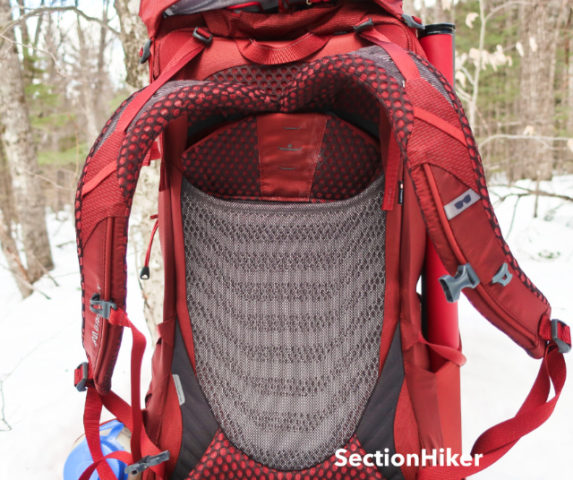
Backpack Frame and Suspension
If the storage, organizational, compression, and external attachment features on the Baltoro haven’t wowed you, the backpack frame and suspension system surely will. This is an internal-frame backpack designed for comfortably carrying heavy loads and dynamically adapting to a wide range of different body shapes.
The Baltoro frame is a 360-degree aluminum hoop with an additional horizontal stay to prevent barrelling when the main compartment is overstuffed or carrying a rounded bear canister. That hoop creates an air cavity behind the back panel to help ventilate perspiration, although not as much as a fully ventilated trampoline frame like the one on the Gregory Focal or Facet backpacks. The Baltoro like many of Gregory’s recent models includes a Polygiene anti-odor treatment, also commonly used on hunting backpacks, to prevent sweat from making the backpack smell.

New on this model is a rip-and-stick style adjustable torso length feature that lets you reposition the height of the shoulder straps to lengthen or shrink the distance between the shoulder straps and hipbelt. Available in 3 torso lengths: S (16-19″), M (17-20″), and L (18-21″), each size has three inches of torso length adjustability, with two inches of overlap between the sizes so you can dial in a great fit. The previous version of this pack also had an adjustable torso capability but only had a 2 cm range. This new frame has one that is three inches big making it almost four times larger.
The shoulder pads are S-shaped, not J-shaped, so they can be used by women and men, including men with “well-developed” or broad chests, while the sternum strap height is easy to adjust on a rail system. The pads are heavily padded with wicking mesh covers to provide added comfort and keep you drier.

The top of the shoulder straps are designed to dynamically pivot on hidden hinges as your torso angle changes, so the pack moves with you for scrambling or climbing and you don’t have to fight against its inertia. The pivot mechanism also provides an important fit benefit, even when you’re not moving, since the shoulder straps adapt to your body shape and curves. It’s an innovative way to address individual fit differences across a wide range of different body shapes.

The new hipbelt is seamless and also adjustable in length using a rip-and-stick system, with different hip belt sizes S (26-48″), M (28-50″), L (30-52″) corresponding to the pack’s torso lengths. The hip belt is well padded and also covered with wicking mesh. It closes with a push-forward buckle system for mechanical advantage. Like the shoulder straps, the hip belt has been re-engineered on this new model to adapt to changes in your body position, so that the pack moves with you, enhancing your stability when scrambling or hiking over uneven terrain. The base of the hip belt is still anchored on the frame for load transfer, but there’s a little more freedom of movement in the hip belt wings to adapt to the angle of your hips and gait.
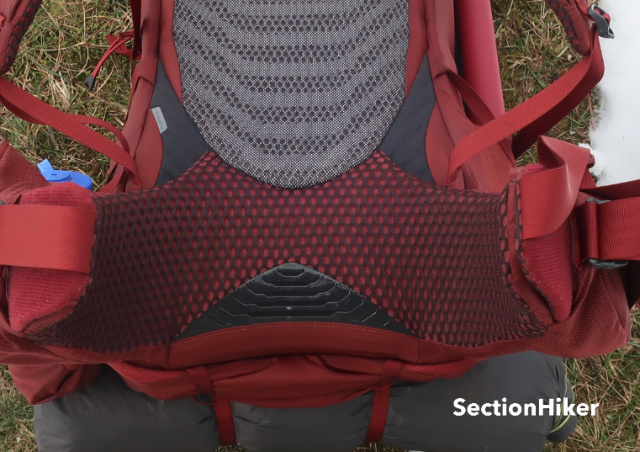
New on this model is an unobtrusive sticky lumbar pad (see above) designed to prevent the hip belt from slipping down the back of your pants. It works great and we think it’s an especially clever addition to a backpack that’s intended to carry heavier loads. The previous model had a similar capability in addition to a removable lumbar pad, but we like this new system better because it is so unobtrusive and simple for a novice user to benefit from.
What’s the Baltoro feel like when it’s bursting with gear? Surprisingly lightweight. The hip belt, frame, and load lifters do such a great job of transferring the load to your hips and keeping the center of gravity close to your spine/core muscles, that heavy loads feel lighter. If you have to carry heavier loads, upwards of 40 lbs, it does pay to have a beefier hip belt and frame to reduce fatigue and increase your comfort.
Comparable Backpacks
| Make and Model | Weight | Access |
|---|---|---|
| Gregory Baltoro 65 | 4 lbs 14.4. oz | Top, front, bottom |
| Gregory Baltoro 75 | 4 lbs 15.7 oz | Top, front, bottom |
| Gregory Katmai 65 | 4 lbs 11.8 oz | Top, bottom, side |
| Gregory Paragon 68 | 3 lbs 11 oz | Top, bottom, side |
| Mountain Hardwear AMG 75 | 4 lbs 15.4 oz | Top |
| Osprey Aether 65 | 4 lbs 14.7 oz | Top, front, bottom |
| Osprey Aether Plus 70 | 5 lbs 8 oz | Top, front, bottom |
| Osprey Aether Pro 70 | 3 lbs 15 oz | Top |
| Osprey Atmos AG 65 | 4 lb. 9 oz | Top, bottom, 2 sides |
| REI Trailbreak 60 | 3 lbs 13 oz | Top, bottom |
Recommendation
The Gregory Baltoro 65 is a highly configurable, high-volume backpack designed for carrying heavy or high-volume loads, north of 40 lbs. It’s loaded with features that make it easy to pack and organize your gear, with an innovative frame and suspension system that lets you dial in a custom fit. While the storage and organization of this new Baltoro is quite similar to the previous model, the frame and suspension system were redesigned to fit a broader range of sizes and body shapes, out of the box. The previous model often required the purchase of replacement shoulder straps or a hipbelt if you needed to alter the pack’s fit. That made it much more difficult for retailers and consumers to support or configure. The new adjustable torso and hip belt provide a level of adjustment that is used by many brands, including Gregory’s other backpacks and is much more familiar for consumers to use.
Who is this pack designed for? It’s intended for backpackers who need to carry higher volume, heavier loads when hiking with a family group (where dad carries more), for couples, or extended backpacking trips with infrequent resupply. When you carry a high-volume backpack, you quickly discover the value of having multiple access points (top, bottom, panel) to extract gear without having to unpack the entire load to get gear at the bottom of the pack. The same goes for having more closed external pockets, like the three in the Baltoro top lid and the two long pockets sandwiched in between the front mesh pocket and the main compartment. The Baltoro is pretty unique and highly functional, in this respect, when compared to other backpacks in its volume class.
If you own the previous model of the Baltoro, I don’t think you need to upgrade to the new version unless you’ve struggled with fit issues, because the way the pack carries under load is remarkably similar to that of the previous model. There are a few minor changes to the pack’s storage and organization layout that are different. For example, the pockets on the top lid are now stacked instead of side by side, the removable hydration pocket/day pack has been eliminated, as well as the waterproof accessory pocket on the hip belt.
Disclosure: Gregory donated a backpack for this review.
Compare 3 Prices
-
 REI
REI$299.95$224.73View -
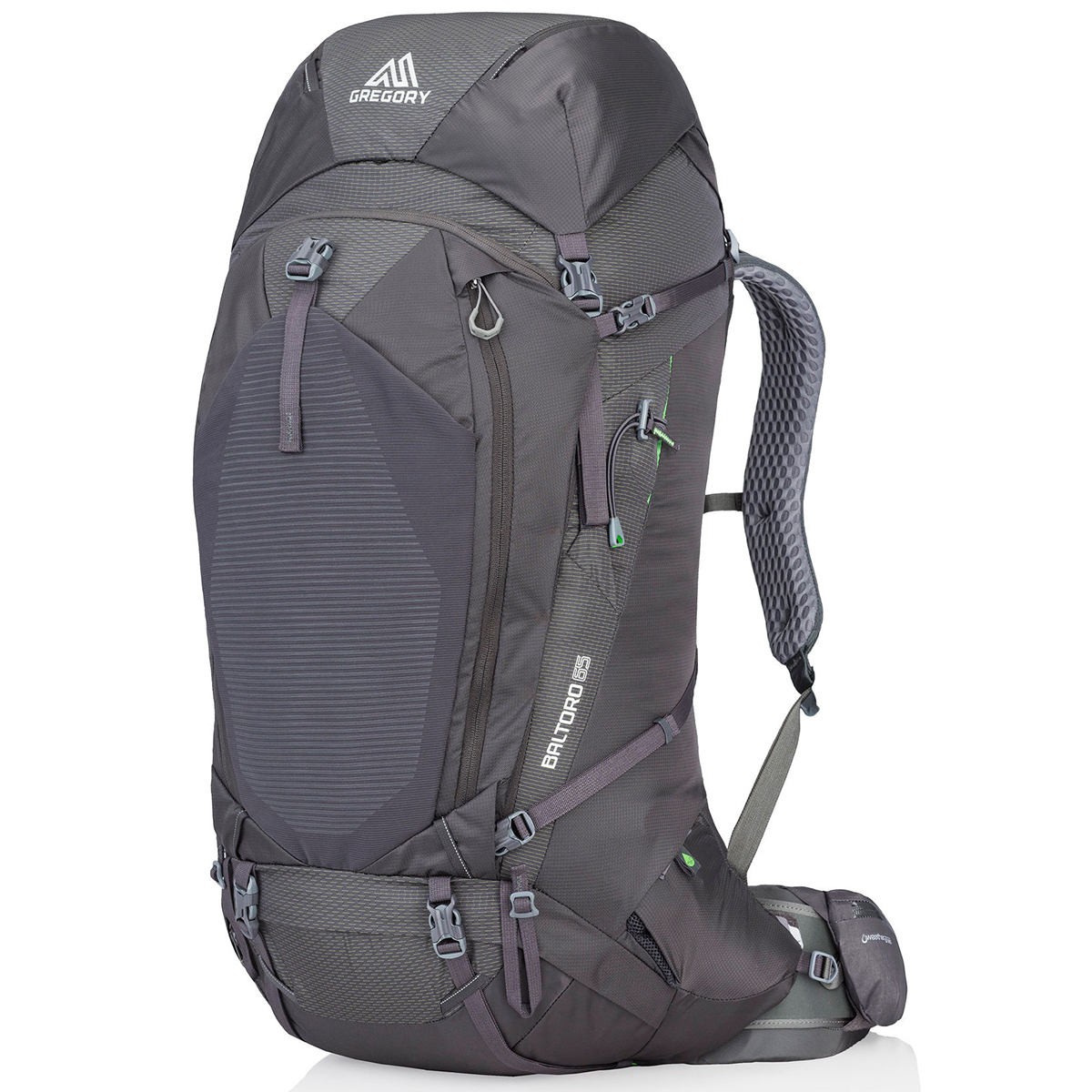
 Eastern Mountain Sports
Eastern Mountain Sports$299.95$239.98View -

 Amazon US$310.39View
Amazon US$310.39ViewAmazon.com Price: $310.39 (as of 04/24/2024 20:30 GMT-0400) Details
Product prices and availability are accurate as of the date/time indicated and are subject to change. Any price and availability information displayed on Amazon.com at the time of purchase will apply to the purchase of this product.
 SectionHiker.com Backpacking Gear Reviews and FAQs
SectionHiker.com Backpacking Gear Reviews and FAQs 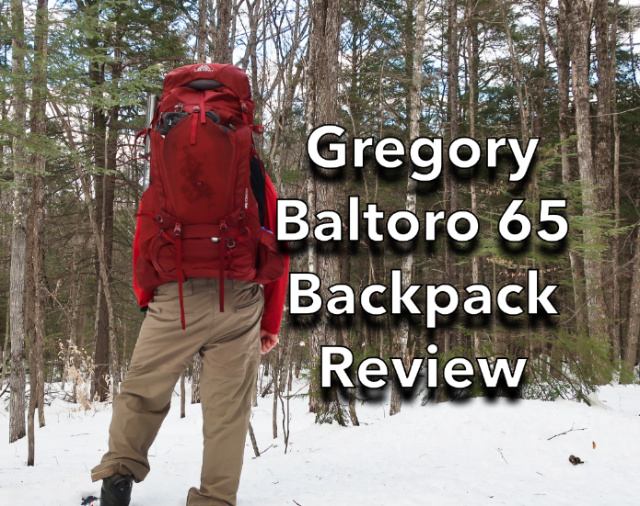

Question on the links – they appear to go to the older models of these packs. Pricing had large discounts. The photos and videos I looked at on Amazon show the person removing the hydration bladder you indicated was discontinued and the hip belt pocket had a “weather shield” logo of some sort, which sounds like the old waterproof compartment you mentioned going away. Any idea how to determine if what the retailer is showing is the new model you reviewed? This looks like a fantastic backpack and I’m definitely interested.
If it’s discounted it’s the old model. You can also tell (if they have decent photos) that the weather-proof pocket has been removed. The lumbar area of the hip belt is also different. I’ve complained about the fact that retailers don’t differentiate between “versions” of packs before, but I doubt that anything will change. Another option is to buy direct from Gregory, but they don’t have a very friendly return policy like REI – 30 days, I believe, instead of one year.
I have the previous version of this and it is supremely comfortable. Over twice the weight of my Mariposa50, but so much more comfortable imo.
Always a tradeoff between lightweight and comfort. If you have to haul a lot of stuff a long way, it can really pay to get a much beefier pack. The hunting public still understands this, for instance.
Does this pack actually come with a rain cover? I see it indicates but it’s not mentioned in the review. Gregory and REI websites don’t show it having a rain cover included.
It does mention a rain cover. It’s also listed in the specs section. And yes it comes with a rain cover.
I checked it out at REI in person and it does not come with a rain cover. The old version did. Unfortunately it also does not come with the removeable summit pack anymore either. Both are now sold separately at Gregory’s webpage for $39.95 each. Talk about nickel and diming!
Mine came with a red rain cover, same color as the pack. Came straight from Gregory…let me look into this with them and try to sus it out for you.
I asked Gregory directly myself, but feel free to as well. I’d hate to think they provided raincovers to their promotional packs knowing they wouldn’t be included when they came up for sale. This was their reply to me, I’ve seen the exact wording posted elsewhere as well. Seems to be their boilerplate response. They want you to use the raincover that came with your old pack, lol. Seems a big ask for such an expensive pack. What if you don’t have an old raincover? What if you don’t want to put a dirty old raincover with holes in it on your brand new pack?
“Like the rest of the world, we are experiencing large increases in materials, labor, and freight costs. When costs increase rapidly, every brand is faced with tough product design and quality decisions. We can tell you with absolute certainty that Gregory will remain 100% committed to maintaining our world-class quality, which will continue to be covered by our Lifetime Guarantee. In order to not compromise on this commitment, we must decide how much to increase prices and what extra features we include in our products to benefit backpackers, hikers, and travelers. No longer offering an included raincover with every pack purchase is a great example. In this case, we have prioritized continuing to deliver a high-quality product, now built with recycled materials, with the most comfortable, adaptable harness and hip belts that we’ve ever built, over the raincover add-on that many hikers already have, or will not need for their adventures. This means our consumers are not required to pay extra for a raincover in every pack they buy and allows us to continue offering other amazing features, enhance the quality of the rest of the pack, and maintain fair prices for everyone.”
You’ll need to pay $80 extra if you want the same pack as before. Feels like the value has gone down. Removing the “WeatheShield” hip belt pocket feels like another downgrade too. Thankfully my Baltoro75 doesn’t need replacing anytime soon.
Thanks for chasing that down. I’ve changed the review to reflect the fact that a rain cover is not included. It is somewhat embarrassing that they included a rain cover with the backpack they sent me to review and don’t include it in shipping product. Given how cheap a rain cover is to manufacture, I think they made the wrong decision to remove it, especially on a premium backpack like the Baltoro.
Hey, thanks for the review. I have the previous iteration of this pack. It is supremely comfortable and though pretty heavy, I love it. I think the comfort and durability are worth it.
It did come with both a rain cover, in the underside pocket of the lid, and the little blatter holder/summit pack.
However, the one thing that drives me crazy about this pack is the size of the hip belt pockets. They are ridiculously tiny. I’m not a big guy but i can barely fit my hands in these pockets. Forget about a large cell phone, a small pair of binoculars or even a good handful handful of beef jerky.
My question is; do you know if this new hipbelt, with its ‘larger’ pockets will attach to the previous model of this pack?
The hipbelt on the 2022 Baltoro is not detachable at all.
This is an excellent review. The picture of the BV500 sideways is worth 1000 words. There are very few packs that can pull that off. Please keep up the good work and good reviews. Craig.
I’ve tried the Boltero at REI and absolutely loved the comfort factor. I just couldn’t get over the nearly 5lb weight, however. The Ultralight Equipment Company’s Catalyst come s in at 2.75lbs., holds a BV500 sideways and has huge side pockets and back mesh compartment. I wish Gregory could lighten up the Baltero because it is a very comfortable pack.
I have a Baltoro 85. I Love it in cold weather for carrying my bulky winter bag, extra clothing, a larger stove and cookset, and the larger and heavier 4-season tent. Also for the extras I carry for the group when I take the boy scouts out backpacking. I love the detachable water bladder day pack and use it when the water source is a half-mile away or taking side trips from a “base camp”. The zipper pulls are larger than on my other packs, which aid in winter access. But I found the pull tabs on the pockets confusing when they are all pulled up to the top together. So i stuck on some differently colored reflective tape strips.
I have the old model 75, and I agree with everything you say. Its a great hauler pack and super comfortable when it transfers that weight to your hips. Would you pay $40 more for the detachable water bladder day pack? They no longer include it in the Baltoro line and instead sell it separately as the “Nano14” on their website. As much as I like it, and I do use it as a summit pack, I don’t think I would pay extra to get it. Its great as an included feature, but isn’t worth spending additional money for.
Look forward to a review of the new Gregory Focal. Interestingly enough I noticed on their website that they stated the max carry capacity of it was 15.9 lbs. I knew this couldn’t be right and commented on their Instagram about it. They almost immediately responded saying that was a an error and the Focal 58 carries up to 35 lbs.
This pack looks like a good alternative to the Osprey Exos, especially since it has hipbelt pockets. Unfortunately no daisy chain shoulder straps :(
Was the Gregory Deva 60 upgraded as well?
Yes.
Good to see they look to finally have proper hip belt pockets. I had a Baltoro made in 2016. Pockets were too small, IMO.
One thing that sort of bugs me is the giant access panel zipper. I just don’t trust large zippers that would result in losing gear onto the ground if they failed while hiking, let alone having to deal with sealing it up during a zipper failure far from the trailhead.
Also kind of surprised they are sticking to their guns on the silly water bottle holder system. A lot of us like to balance out the weight of the pack with two water bottles. The system they have is terrible if you want to use a water bottle that is larger or smaller than the bottle holder. It either then flaps around or doesn’t fit at all. It’s also terrible to use it for anything other than a perfectly sized water bottle. It’s honestly one of the dumbest things I have seen designed onto a backpack. For people who struggle to use water bottles in normal side pockets, and always use the standard nalgene, and only use one bottle, then it seems great, I guess. Only thing I think of that would be ideal is if someone who is using a hydration tubing system and not water bottles, they could find a way to use the water bottle holder as a bear spray holder. I’m stretching a bit here. haha
The bottle holder does fold into the pack and doesn’t flap around as you suggest. But on the issue of side water bottle pockets, this just isn’t the pack to get if you like that kind of thing. I can think of a lot of climbing and winter packs that are designed the same way and they’re perfectly fine. If the big rear zipper were to fail, which would be hard to imagine because they put a huge one on this pack, you could simply run the compression straps around the back and keep your stuff from falling out.
I just returned the Baltoro for an osprey atmos 65 due to the brain cinch straps would not hold. I cinch them down tight, pull on the brain and they slip and the brain pulls up like you didn’t even couple the cinch straps. The ospreys shoulder straps do not open far enough and is a pain to get in and out of. I really want the Baltoro back but not with the straps not holding tight…… other than that, I loved it
Are you sure it was the recent version of the Baltoro? People are still selling ones from three generations ago at full retail.
Hi! I need your advice on choosing a backpack.
My goal is true-winter mountains hiking at 35-40 lbs (weight includes crampons, snowshoes, ice axe, typical gas and food, but excludes backpack weight).
I’m thinking about buying this backpack or something lighter like a SWD or Seek Outside.
What do you think, is it worth paying more than double for these options? ~230$ Baltoro 65 vs ~500+$ SWD/SO with extras.
My main struggle – will they provide less comfort for carrying similar weight, and the excess weight of the backpack will not be felt in such a scenario? Or worth it?
Or possibly can you suggest some more interesting options for this use?
I would be grateful for your opinion.
I’d get the Baltoro. It’ll be far more comfortable, it can carry more weight, and its set up to be a mountaineering pack.